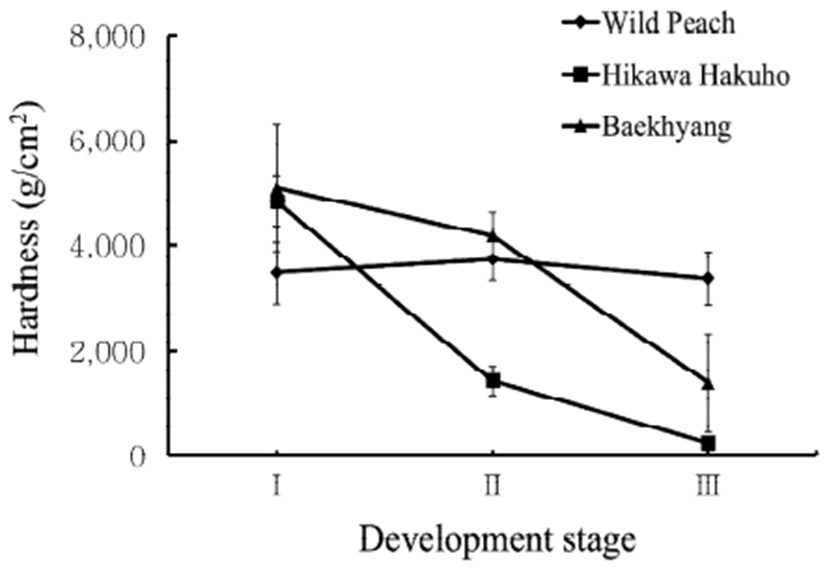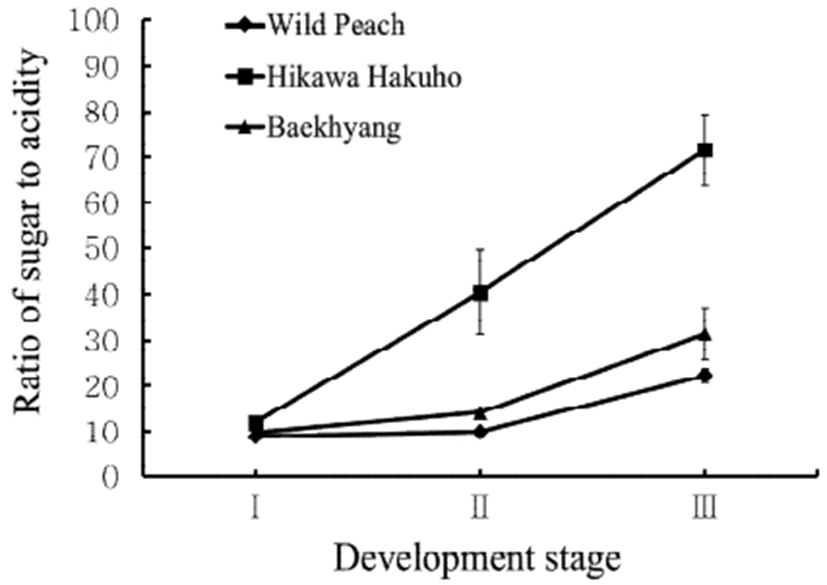서 론
복숭아는 장미과(Rosaceae) 자두속(Prunus) 복숭아아속(Amygdalus)에 속하는 온대 낙엽성 과수로 대표적인 여름 과일이다. 복숭아는 국내 과일 생산량 중 감귤, 사과, 포도, 배, 단감에 이어 6위로 국내 전체 과일 생산량의 8%를 점유하고 있으며, 2015년 기준으로 현재 우리나라 복숭아 재배면적은 16,704 ha, 생산량은 237,711 ton이다(1). 복숭아는 malic acid, tartaric acid, citric acid 등의 유기산이 함유되어 있고, aspartic acid, glutamic acid, serine 등 유리 아미노산의 함량이 높다(2,3). 복숭아는 재배과정에서 해거리 방지, 착과량 조절 등의 목적으로 3-4회에 걸쳐 30-40%의 미숙과의 적과를 실시하는데, 이때 적과된 복숭아는 대부분 활용되지 못하고 전량 폐기되고 있어, 부가가치 창출 및 가격 안정화를 위해 적과된 복숭아 유과의 활용이 필요한 실정이다. 사과 미숙과의 경우는 완숙과보다 폴리페놀화합물의 함량과 항산화 활성이 높아서(4) 기능성 소재로서 주목받고 있다.
복숭아 유과는 oxalic acid를 비롯한 유기산과 아미노산이 풍부하며(5), 섭취에 따른 용혈성 빈혈 개선 효과(6), 추출물의 미백 효과(7) 등이 보고되었다. 또한 성숙에 따라 amygdalin 함량(8), 펙틴 성분 및 관련 효소 활성(9,10), 항산화 및 항염증 효과(11) 등이 보고되었다.
최근 식생활을 통한 대사성 질환의 예방과 노화 방지 목적으로 식용식물자원의 생리활성물질과 생체 기능성에 관하여 많은 연구들이 이루어지고 있으며, 이중 폴리페놀화합물과 생체 항산화 기능성에 관한 연구가 많다.
따라서 본 연구는 복숭아 유과를 고부가가치 기능성 소재로써 활용 가능성을 제고하기 위하여, 품종별로 성숙 시기에 따라 이화학적 특성과 항산화능을 조사하여 보고하는 바이다.
재료 및 방법
실험 재료는 돌복숭아(Wild Peach, Pruns persica L.), 일천백봉(Hikawa Hakuho, Pruns persica L.), 백향(Baekhyang, Pruns persica L.) 품종을 사용하였으며 2017년 청도 복숭아 시험장에서 품종별로 각각 경핵기(stone hardening stage), 과실비대기(fruit enlargement stage), 성숙기(ripening stage)에 채취하였다. 경핵기는 6월 중순경 적과 시기에 세 품종 모두 같이 채취하였으며, 과실비대기의 경우 돌복숭아는 8월 상순경, 일천백봉은 7월 상순경, 백향은 7월 하순경에 채취하였다. 성숙기의 경우 돌복숭아는 9월 상순경, 일천백봉은 7월 하순경, 백향은 8월 하순경에 각각 채취하여 실험 재료로 사용하였다.
성숙 시기별로 경핵기, 과실비대기, 성숙기에 채취한 복숭아 과일의 과경, 과폭, 과중, 경도, 당도, 산도를 측정하였다. 과경 및 과폭은 ALLTRADE dial caliper(Long beach, CA, USA)로, 과중은 METTLER TOLEDO digital balance (B3002DR, Schwarzenbasch, Switzerland)로 측정하였다. 경도는 Rheometer(Compac-100, Sun Scientific Co., Tokyo, Japan)로 aluminium cylinder probe를 사용하여 측정하였다. 당도는 굴절당도계(ATAGO-N-1a, Antage, Tokyo, Japan)로 측정하였다. 산도는 0.1 N sodium hydroxide로 pH 8.1까지의 적정액을 주석산 함량으로 환산하여 총산 함량(%, w/v)으로 표시하였다(12).
복숭아 과일의 항산화능으로는 총페놀 함량과 DPPH 라디칼 소거능을 측정하였다. 총페놀 함량은 Hammerschmidt의 방법(13)에 따라 측정하였으며, chlorogenic acid를 이용하여 표준곡선을 작성하였으며 mg%로 나타내었다.
DPPH 라디칼 소거능은 Blois(14)의 방법으로 조사하였다. 시료 0.2 mL와 4×10-4 M α,α-diphenyl-β-picrylhydrazyl (DPPH) 용액 0.8 mL을 가하여 10초간 혼합하고 10분간 방치한 후 525 nm에서 흡광도를 측정하여 아래와 같이 계산하였다.
결과 및 고찰
복숭아 과일의 성숙 시기별 과경, 과폭, 과중 및 과경/과폭의 비를 조사한 결과는 Table 1과 같다. 과경과 과폭, 과중은 모든 품종에서 숙기가 지날수록 증가하는 것을 알 수 있었다. 특히 성숙기에서 품종별로 과경과 과폭, 과중에서 백향, 일천백봉, 돌복숭아 순으로 높았다(p<0.05). 과경/과폭의 비의 경우 돌복숭아와 일천백봉에서는 숙기가 지날수록 감소하는 경향을 보였으며, 백향은 과실비대기까지 감소하였으나, 성숙기와는 차이가 없었다. 성숙기에서의 과경/과폭의 비는 백향이 가장 컸으며, 일천백봉이 0.83으로 성숙이 진행될수록 과경보다 과폭의 성장이 더 큰 것을 알 수 있었다.
복숭아 과일의 성숙 시기별 경도를 조사한 결과는 Fig. 1과 같다. 숙기가 진행됨에 따라 일천백봉의 경도는 4,838 g/cm2에서 250 g/cm2으로, 백향의 경도는 5,098 g/cm2에서 1,394 g/cm2로 감소함을 볼 수 있었다. 반면 돌복숭아의 경우 경도가 숙기가 진행됨에도 불구하고 경도(3,378-3,730 g/cm2)의 차이를 보이지 않았다. 복숭아와 같은 핵과류인 매실도 마찬가지로 성숙함에 따라 경도가 감소함을 보였다(15).

복숭아 과일의 성숙 시기별 당도와 산도를 조사한 결과는 Table 2와 같다. 당도의 경우 복숭아 모든 품종에서 경핵기보다 과실비대기에서 증가하였으며, 과실비대기와 성숙기는 유의적인 차이를 나타내지 않았다. 경핵기에서의 당도는 돌복숭아가 가장 낮았고, 과실비대기에서는 백향이 가장 높은 값을 나타냈다. 성숙기에서의 품종별로 당도는 유의적인 차이를 보이지 않았다. 이는 복숭아 과일의 성숙 시기에 따른 당도를 측정한 Cascales 등(16)의 연구와 비슷한 경향을 나타내었다. 복숭아 과일의 산도는 일천백봉과 백향에서 숙기가 진행될수록 감소하였다. 모든 시기에서 일천백봉이 가장 낮은 산도를 나타냈으며, 경핵기를 제외한 모든 시기에서 돌복숭아가 가장 높은 산도를 보였다. 이는 자두의 성숙에 따라 산도가 감소하며, 가용성 고형분 함량은 반대로 증가한다는 보고(17)와 유사하였다.
복숭아 과일의 성숙 시기별 당도/산도의 비(당산비)를 나타낸 결과는 Fig. 2와 같다. 경핵기에서는 품종별로 당산비가 큰 차이를 보이지 않았다. 성숙에 따라 복숭아 과일의 당산비는 증가하였으며, 특히 일천백봉이 돌복숭아와 백향에 비해 큰 폭으로 증가하였다. 이는 성숙 시기에 따라 당도는 품종별로 비슷하지만 일천백봉의 산도가 다름 품종 보다 낮기 때문이다.

복숭아 과일을 성숙 시기별로 총페놀 함량과 DPPH 라디칼 소거능을 측정하여 항산화능을 조사한 결과는 Table 3과 같다. 식물의 2차 대사산물로서 phenolic acid, flavonoid, anthocyanin, condensed tannin과 같은 다양한 구조의 화합물을 폴리페놀 화합물이라고 하며, 유리 라디칼 소거와 금속 이온을 포착하는 반응에 직접 참여하는 항산화 활성을 비롯하여(18), 콜레스테롤 저하작용, 정장작용, 항암 및 항산화 작용 등과 같은 다양한 기능성이 보고되고 있다(19). 복숭아 과일에 존재하는 폴리페놀 화합물의 종류로는 neochlorogenic acid, chlorogenic acid, catechin, quercetin-3-O-galactoside 등이 있다(20).
복숭아 과일의 성숙 시기별 총페놀 함량은 모든 품종에서 경핵기보다 성숙기의 총페놀 함량이 크게 감소한 것을 볼 수 있었다. 모든 시기에서 백향의 총페놀 함량이 돌복숭아와 일천백봉보다 높았다. 경핵기에서는 일천백봉이 가장 낮은 총페놀 함량을 보였으나, 과실비대기와 성숙기의 총페놀 함량은 품종 간에 유의적인 차이를 보이지 않았다.
복숭아 과일의 성숙 시기별 DPPH 라디칼 소거능은 총페놀 함량과 유사하게 모든 품종에서 경핵기에 비해 성숙기에서 감소하였다. 또한 모든 시기에서 백향의 DPPH 라디칼 소거능이 돌복숭아와 일천백봉에 비해 높았다. 돌복숭아가 일천백봉에 비해 경핵기와 과실비대기에서 높은 라디칼 소거능을 보였으나, 성숙기에서는 유의적인 차이가 없었다. 복숭아 과일의 총페놀 함량과 DPPH 라디칼 소거능의 상관계수는 0.7083(p<0.0001)으로, 다소 상관성이 있었으며, 품종별로 성숙도에 따라 항산화 활성과 항산화성분을 조사한 Jung 등(11)의 연구결과와 유사하였다.
요 약
본 연구는 복숭아 과일의 이용성을 증대할 목적으로, 품종별로 복숭아 과일의 성숙 단계에 있어서 이화학적 품질 특성과 항산화능을 조사하였다. 물리적 특성은 과일의 과경, 과폭, 과중 및 경도를 측정하였으며, 화학적 특성은 총산도, 당도를 측정하였고, 항산화능으로 총페놀 함량과 DPPH 라디칼 소거 활성을 측정하였다. 복숭아 과일의 품종별 과경, 과폭, 과중은 숙기가 진행됨에 따라 점점 증가하였으며 과경의 경우 돌복숭아가 가장 작았고, 백향이 가장 컸다. 과폭과 과중에 있어서 경핵기의 경우 돌복숭아가 가장 작았고 일천백봉이 가장 컸으나, 과실비대기와 성숙기에서는 백향, 일천백봉, 돌복숭아 순으로 과중이 컸다. 과폭에 대한 과경의 비율은 성숙하면서 감소하는 경향을 보였다. 경도는 일천백봉과 백향의 경우 숙기가 진행됨에 따라 현저하게 감소하였으나 돌복숭아의 경우는 숙기가 진행되어도 비슷한 정도의 경도를 보였으며, 성숙기의 경도는 돌복숭아, 백향, 일천백봉 순으로 높았다. 복숭아 과일의 품종별 당도는 경핵기에 가장 낮았으며, 성숙되면서 모든 품종이 증가하는 경향을 보였다. 복숭아 과일의 산도는 반대로 감소하여, 당산비가 증가하는 경향을 보였으며, 성숙기의 일천백봉이 현저히 당산비가 높았다. 총페놀 함량은 경핵기의 백향이 가장 높았고, 성숙함에 따라 총페놀 함량이 감소하였다. DPPH 라디칼 소거능은 경핵기에서 돌복숭아가 가장 높았으며, 과실비대기와 성숙기에서는 품종별로 유의적인 차이가 없었다. 복숭아 과일은 성숙함에 따라 과경, 과폭, 과중은 증가하며, 경도가 감소하여, 당산비가 증가하였으며 항산화능은 감소하였다(p<0.05).
